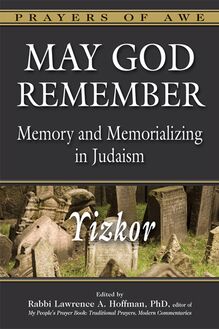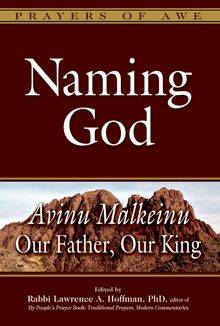Naming God , livre ebook
200
pages
English
Ebooks
2015
Vous pourrez modifier la taille du texte de cet ouvrage
Obtenez un accès à la bibliothèque pour le consulter en ligne En savoir plus
Découvre YouScribe en t'inscrivant gratuitement
Découvre YouScribe en t'inscrivant gratuitement
200
pages
English
Ebooks
2015
Vous pourrez modifier la taille du texte de cet ouvrage
Obtenez un accès à la bibliothèque pour le consulter en ligne En savoir plus
Publié par
Date de parution
22 juin 2015
Nombre de lectures
0
EAN13
9781580238427
Langue
English
Publié par
Date de parution
22 juin 2015
Nombre de lectures
0
EAN13
9781580238427
Langue
English
Thank you for purchasing this Jewish Lights eBook!
Sign up for our e-newsletter to receive special offers and information on the latest new books and other great eBooks from Jewish Lights.
Sign Up Here
or visit us online to sign up at www.jewishlights.com .
Contents
Introduction: Why This Book: And Why It Is the Way It Is
Rabbi Lawrence A. Hoffman, PhD
PART I: TWO OVERVIEWS
The History, Meaning, and Varieties of Avinu Malkeinu
Rabbi Lawrence A. Hoffman, PhD
Our Father and King : The Many Ways That Liturgy Means
Rabbi Lawrence A. Hoffman, PhD
PART II: THE LITURGY
Editor s Introduction to Avinu Malkeinu
Rabbi Lawrence A. Hoffman, PhD
Translator s Introduction to Avinu Malkeinu
Dr. Joel M. Hoffman
Avinu Malkeinu : A New and Annotated Translation
Dr. Joel M. Hoffman
Translator s Introduction to Ki Hinei Kachomer
Dr. Joel M. Hoffman
Ki Hinei Kachomer : A New and Annotated Translation
Dr. Joel M. Hoffman
PART III: AVINU MALKEINU : THE MUSIC
The Music of Avinu Malkeinu
Gordon Dale, MA
Who s Your Daddy?
Chazzan Danny Maseng
PART IV: PRECURSORS, FOUNDATIONS, AND PARALLELS
Biblical Precursors: Father, King, Potter
Dr. Marc Zvi Brettler
Father or King: A View from the Psalms
Rabbi Jonathan Magonet, PhD
Why Our Father ?
Dr. Annette M. Boeckler
Prayer and Character: The Story behind Avinu Malkeinu
Rabbi Elie Kaunfer, DHL
Divine Epithets and Human Ambivalence
Rabbi Reuven Kimelman, PhD
Our Father, Our King: Old and New Parables
Dr. Wendy Zierler
Empowerment, Not Police: What Are We to Do with Problematic Liturgical Passages?
Rabbi Dalia Marx, PhD
Why We Say Things We Don t Believe
Rabbi Karyn D. Kedar
PART V: HOW PRAYER BOOK EDITORS DEAL WITH NAMING GOD
A British Father and a British King?
Rabbi Paul Freedman
Avinu Malkeinu and the New Reform Machzor (Mishkan HaNefesh)
Rabbi Edwin Goldberg, DHL
What Is God s Name?
Rabbi David A. Teutsch, PhD
Changing God s Names: The Liturgy of Liberal Judaism in Great Britain
Rabbi Andrew Goldstein, PhD, and Rabbi Charles H. Middleburgh, PhD
PART VI: MASCULINE IMAGERY; FEMINIST CRITIQUE
So Near and Oh So Far
Rabbi Laura Geller
Our Rock, Our Hard Place
Catherine Madsen
What s in a Word? Or, How We Read and Hear Our Prayers
Ruth Messinger
Rescuing the Father-God from Delray Beach
Rabbi Jeffrey K. Salkin, DMin
I Do Not Know Your Name
Rabbi Sandy Eisenberg Sasso, DMin
PART VII: WHAT S IN A NAME?
Abracadabra: The Magic of Naming
Rabbi Bradley Shavit Artson, DHL
My Name Is Vulnerability
Rabbi Tony Bayfield, CBE, DD
We Are But Dust
Dr. Erica Brown
Two Pockets
Rabbi Joshua M. Davidson
Re-imaging God
Rabbi Lawrence A. Englander, CM, DHL, DD
Would You Still Love Me If...?
Rabbi Shoshana Boyd Gelfand
Celebrating a Conflicted Relationship with God
Rabbi Asher Lopatin
God the Cashier: A Parable of the Dubner Maggid s
Rabbi Jack Riemer
Piety and Protest
Rabbi Dennis C. Sasso, DMin
The Most Difficult Name for God, You -Or, How Is Prayer Possible?
Rabbi Jonathan P. Slater, DMin
Machzor and Malkhut : The Challenge of Naming a King
Rabbi David Stern
We Guess; We Clothe Thee, Unseen King
Rabbi Margaret Moers Wenig, DD
From Direct Experience to a World of Words: The God We Struggle to Know
Rabbi Daniel G. Zemel
Appendix A: Avinu Malkeinu through Time
Rabbi Lawrence A. Hoffman, PhD
Ashkenazi-Polish Rite ( Minhag Polin )
Our First Extant Prayer Book, Babylonia, circa 860 CE ( Seder Rav Amram )
France, Eleventh to Twelfth Centuries ( Machzor Vitry )
Italy, Thirteenth to Sixteenth Centuries ( Machzor Roma )
Ashkenazi-German Rite ( Minhag Rinus )
England, Turn of the Twentieth Century ( Minhag Sepharad )
Yemenite Tikhlal (the Baladi Rite)
Chabad ( Minhag Lubavitch , Minhag Ari as adapted by Rabbi Schneur Zalman of Liadi, the founder of Chabad)
Appendix B: Alternatives to Avinu Malkeinu
Rabbi Dalia Marx, PhD
From Israel: Kavanat Halev , Reform, 1989
From the UK: Forms of Prayer (Draft Edition), Reform, 2014
From North America: Mahzor Lev Shalem , Conservative, 2010
From North America: Mishkan HaNefesh , Reform, 2015
From North America: Kehilla Community Machzor , Renewal, 2014
Notes
Glossary
Online Addendum: Modern Translations of Avinu Malkeinu
Rabbi April Peters
Available as a free download at www.jewishlights.com .
About the Editor
Copyright
Also Available
About Jewish Lights
Sign Up for Email Updates
Send Us Your Feedback
Introduction
Why This Book: And Why It Is the Way It Is
Rabbi Lawrence A. Hoffman, PhD
Rabbi Lawrence A. Hoffman, PhD, has served for more than three decades as professor of liturgy at Hebrew Union College-Jewish Institute of Religion in New York. He is a world-renowned liturgist and holder of the Stephen and Barbara Friedman Chair in Liturgy, Worship and Ritual. He has written and edited many books, including the My People s Prayer Book: Traditional Prayers, Modern Commentaries series, winner of the National Jewish Book Award; and the Prayers of Awe series; and he is coeditor of My People s Passover Haggadah: Traditional Texts, Modern Commentaries , a finalist for the National Jewish Book Award. He cofounded and developed Synagogue 2/3000, a transdenominational project designed to envision and implement the ideal synagogue of the spirit for the twenty-first century.
O f all the books in the Prayers of Awe series so far, this one has proved most surprising. When books are planned, one never knows what the research will turn up, and the topic of Avinu Malkeinu has turned out to be quite amazing.
I wondered at the outset if Avinu Malkeinu should even make it into this series. The original plan was to focus on prayers that present modern worshipers with significant difficulties-a criterion under which Avinu Malkeinu certainly qualified, on account of its redundant masculine imaging of God as a father and king. I worried, however, that the prayer might not have enough about it to fill up an entire volume. Secondary literature on it is exceptionally sparse. Halakhic discussion about its use is sparse to nonexistent.
But further consideration suggested that Avinu Malkeinu was part of a larger issue of naming God. So I added to the book s content the medieval poem ( piyyut ) known as Ki Hinei Kachomer ( Like clay in the hand of the potter )-a composition that supplements Our Father and Our King with a great many other ways to conceptualize the divine.
To my surprise, Avinu Malkeinu alone presented far more depth than I had anticipated. This book therefore presents both Avinu Malkeinu and Ki Hinei Kachomer , but overwhelmingly contributors have focused on Avinu Malkeinu as their primary topic. And for good reason. I can think of few prayers that demonstrate so clearly the process by which Jewish liturgy grew through the ages. The images of God as father and king go back to the Bible; a prayer addressed to Avinu Malkeinu is presented in the Talmud as going back to the second century; a full prayer based on that early Rabbinic paradigm turns up only in the ninth century; not until later in the Middle Ages does that prayer make its way into Jewish liturgy worldwide, and it now can be found in many different versions. This process of growth and diversification is itself a valuable corrective to the common assumption that the wording of our prayers goes back unfailingly to antiquity.
In addition, there is the issue that recommended Avinu Malkeinu in the first place: the feminist critique expanded to include the larger question of how we have the audacity to name God altogether. One after another, contributors have shed important light on how we ought to think this matter through.
Each book in the Prayers of Awe series is organized according to the content of the various contributions, a matter that cannot be determined in advance of their being written. I collect what people have to say and then arrange it all in an order that best sheds light on the nature of the topic. The very organization of this volume demonstrates the surprising depth of its subject.
We begin with my own two editorial overviews of the topic. The first ( The History, Meaning, and Varieties of Avinu Malkeinu ) provides the story behind Avinu Malkeinu -how it developed through time to become what it is today, and how that history illustrates Jewish liturgical creativity in general. Important liturgical landmarks turned out to be Seder Rav Amram , our first comprehensive prayer book from the ninth century; Machzor Vitry , our first large-scale glimpse of Franco-German liturgy that became the Ashkenazi tradition; and assorted evidence for the the Sephardi tradition, emanating from Jews who were exiled from Spain in 1492 and who then carried their tradition northward through Holland, England, and the New World or eastward through the Mediterranean, where it was transformed by medieval Kabbalah from the Land of Israel.
My second overview ( Our Father and King : The Many Ways That Liturgy Means ) supplements the historical record by adding liturgical theory from the disciplines of philosophy, literature, and linguistics. People mistakenly think that the liturgy describes reality in the same way that science does. In reality, prayers do a whole lot more than that. Naming God, then, is far more complex than meets the eye. This second introduction provides the theoretical backdrop necessary to discuss the matter of naming, intelligently.
With these overviews behind us, we turn to the liturgy itself: Avinu Malkeinu : A New and Annotated Translation and Ki Hinei Kachomer : A New and Annotated Translation by Dr. Joel M. Hoffman, who combines his expertise in linguistics and in Hebrew to give a fresh understanding of what these prayers have to say. Every one of our volumes features such a translation, but in this case, the variety of Avinu Malkeinu s many versions posed a unique chall





